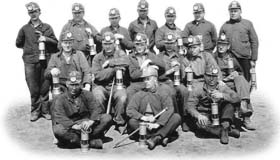



    |
|
|
Sense of Community
|
|
The arrival of the great steel and coal age in Cape Breton and large investments in these industries brought about a tremendous population boom on the island. The area experienced exceptionally high growth rates between 1891 and 1911, with the immigrant population reaching 60 percent in some towns. In 1910, 52.5 percent of Glace Bay's population and 51.6 percent of Sydney Mines people had arrived in the last 10 years. The census data for Sydney Mines between 1871-1911 indicates that the distribution of birthplace of the population varied little, suggesting immigrants were consistently recruited from the same areas. Additional research points out that by 1911, the immigrant population had obviously settled into family life, as 79.1 percent of the people in Glace Bay and 69.7 percent in Sydney Mines were Canadian born. By 1921, data indicates that the ethnic origin of Cape Bretoners was mainly Scottish, followed by English, Irish and then Acadian or French. There were smaller numbers of Jewish, Austro-Hungarian, Belgian, Polish and Blacks. Population figures show that there was significant rural depopulation in Cape Breton between 1891 and 1901, as many people were drawn to the coal mines or the steel plants at Sydney and Sydney Mines. In this period as well, Canada's Minister of the Interior, Sir Clifford Sifton, had implemented a vigorous campaign to attract immigrants to meet the country's employment needs. Many were attracted by a recruitment campaign in foreign nations initiated by the Dominion Coal Company and the Dominion Iron and Steel Company. Although immigration had slowed, the coal industry was still a big employer, and would be for many years to come. In 1930, 61 percent of Glace Bay's male population still worked in the coal mines and related industries. After examining some 1911 census data, it is apparent that the new unskilled arrivals were attracted to employment prospects in industry, since many settled in "company" towns. For instance, the 1921 census shows only 105 of 4,047 foreign-born residents lived in communities not involved in coal mining or steel making. This wave of immigration to Cape Breton created a period of adjustment for both the existing community and the immigrants themselves. Naturally, it was a period not without racial tensions. During this time, there was a feeling among many members of the Anglo-Saxon population of Cape Breton that the influx of foreigners would endanger their standard of living. The media, influenced by its readers, reflected the views of the public, and its issues contain various anti-immigrant comments. The chief language was Gaelic and due to their numbers in the mining towns, their culture and language fought off assimilation during the first decade of the twentieth century. Throughout the area, there was a feeling that the Gaelic language was culturally and socially inferior. This perception, coupled with the rapid urbanization and industrialization within the towns, in addition to an English-speaking elite, led to the decline of the Gaelic language in urban and eventually rural Cape Breton. There was, however, a unifying "family feeling," especially among the Scots. 
By the 1920s, tensions among the ethnic groups in the mining community were diminishing. Perhaps due to the Immigration Department's increased restrictions on the coal company's importation of labour and, also, the advent of the First World War in 1914, which slowed down the steady population and industrial growth that Cape Breton was experiencing since the 1800s. As has been stated, many immigrants came from rural Nova Scotia and Newfoundland, and a sizeable number from the British Isles. Many rural Cape Bretoners of Scottish descent moved in from the outlying counties to the industrial area of Sydney and Glace Bay to find work. Arrivals from continental Europe and the West Indies met with cruel local conditions and had more difficulty than the Anglo-Saxons in adapting to their new home and work. Some came for work and jobs, but others immigrated to escape poor conditions in their homelands. 1. The Lebanese people were fleeing oppressive Turkish rule. 2. The Ukrainians were frustrated by the Polish administration. The largest groups came in 1904,1907 and 1912 to work at the steel plant; others came to dig coal in Glace Bay and Dominion. 3. The Lithuanians came to escape conscription. The largest number came in 1906 to work the mines at Sydney Mines. 4. The Jewish immigrants were able to escape persecution, poor conditions in Eastern Europe and fear of conscription. The largest wave of Jews came between 1906-1912 and many settled in the Whitney Pier area and became peddlers. 5. The Italians found work at the steel plant construction and later worked in Sydney Mines. They came from central and southern Italy via Boston and those employed in coal mines migrated from northern Italy. 6. The Polish immigrants came specifically to work in Cape Breton industry, spurred by a promise of employment arrived between 1906-1913. 7. The Greeks came expecting to make enough money and then return home , but most settled in Glace Bay. They came chiefly from the mining areas of Greece. 8. The Blacks came to Sydney to work on construction; some went to Glace Bay's Sterling Area and others to Reserve to work the mines. Most of them came from Alabama around 1889. NEXT PAGE |
|
The History |
The Future
Regional Impact | Mining Techniques | The Museum Main | Glossary | Site Map | Text Only |

Created by Virtual Media Productions Ltd., © 1997.
|